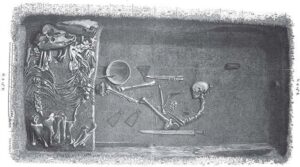Think of a Viking. A four word command, a simple task. And what pops into your mind? Is it something like this picture, like the fierce warrior Leif Erickson?

That’s what transpired when the grave of a Viking was discovered in 1878. This is what was seen (an artist’s rendering):

The assumption – a male skeleton. Now study basic physiology.
A skeleton’s overall size and sturdiness give some clues. Within the same population, males tend to have larger, more robust bones and joint surfaces, and more bone development at muscle attachment sites. However, the pelvis is the best sex-related skeletal indicator, because of distinct features adapted for childbearing. The skull also has features that can indicate sex, though slightly less reliably.
https://naturalhistory.si.edu/education/teaching-resources/written-bone/skeleton-keys/male-or-female (last visited January 23, 2023).
And why, in an article meant for advocacy teachers and coaches, are we writing about Vikings and skeletons? Because from the moment of its discovery until 2017, 141 years later, it was assumed/believed that the skeleton was male, an assumption scientifically refuted with DNA testing that showed the presence of the XX chromosome.
The lessons? In the world of experts (and indeed of all who think), context can shape expectations and thus affect judgment. The pelvic structure of the skeleton did not change – it was the presence of weapons associated with Viking men that led to it being ignored or missed. In the world of forensic experts, this is called “domain irrelevant information.” The only relevant fact is the skeleton – but when the observer is impacted by extraneous facts (here, the weapons) the conclusion can go wrong.
This proposition – that domain irrelevant information can change perception and analysis – has been proved again and again with experts as diverse as fingerprint examiners[1], forensic archaeologists [yes, another erroneous determination of sex][2] and forensic pathologists.[3] So the first takeaway is to learn what extraneous information the analysts had and then test whether that might have distorted the judgment and conclusion.
But there is more – lawyers need to be on task in recognizing biases that may affect judgment. Consider the following testimony from a forensic pathologist in a homicide trial where the dispute was whether this was murder or suicide.
And just as background knowledge, I view every case according to a scientific methodology that I follow.
When you’re reviewing these kind of cases, there’s classification schemes. That’s one classification scheme, potential for suicide.
But you always pursue it, first of all, as a homicide. You have to rule out — as a forensic pathologist, your goal always is to rule out homicide,
I don’t care what kind of case it is. I don’t care how it comes in. I don’t care if it looks like a heart attack.
No matter what the case is you have to force yourself to consider every potential scenario as a homicide. Why? You’ve got to rule that out.
What are the problems here? First is the hollow claim that this is a “scientific” method that the examiner follows. Says who? Or put slightly more articulately, a scientific method is derived from testing and retesting and data analysis. This one? There is no source for such a claim – it is purely ipsi dixit. But more egregious, and also left unchallenged, was the presumption of homicide, or the belief that ‘this is homicide until proved otherwise.’ That is a cognitive bias, a foundational belief that shapes and possibly distorts all the inquiry that follows.
Neither the lawyers nor the judge identified this as a concern. That is not surprising. And before we leave lawyers, let us recognize that biases afflict lawyers. What might be called the cousin of domain irrelevant information is the problem of tunnel vision, one that clearly impacts lawyers.[4] Here, it is an early conclusion that shapes or mis-shapes all future decisions.
Let me offer an example. When a woman was found murdered in her home, a prosecutor went to the scene and saw that she had been a compulsive shopper and hoarder, so much so that the house was filled to the brim with purchases making it almost impossible to walk in the door. The prosecutor’s impression? That this drove the husband crazy, and warranted a charge of passion manslaughter. Where was the tunnel vision? Failing to note the full body haz-mat type suit in the husband’s car trunk, an item that might have suggested planning and premeditation.
The bottom line? Don’t assume all Vikings were men – and look for whatever prejudgment supposition may have tainted an expert’s thinking or your own.
[1] https://www.pbs.org/wgbh/frontline/article/can-unconscious-bias-undermine-fingerprint-analysis/; https://www.ojp.gov/ncjrs/virtual-library/abstracts/why-experts-make-errors
[2] Dror et al, Cascading Bias of Initial Exposure to Information at the Crime Scene to the Subsequent Evaluation of Skeletal Remains, JForensicSci, March 2018, Vol. 63, No. 2doi: 10.1111/1556-4029.13569
[3] Cognitive bias in forensic pathology decisions, Itiel Dror PhD, Judy Melinek MD, Jonathan L. Arden MD, Jeff Kukucka PhD, Sarah Hawkins JD, Joye Carter MD, PhD, Daniel S. Atherton MD, First published: 20 February 2021 https://doi.org/10.1111/1556-4029.14697
[4] See, e.g., Findley and Scott, The Multiple Dimensions of Tunnel Vision in Criminal Cases, Wisconsin Law Review 2006.
